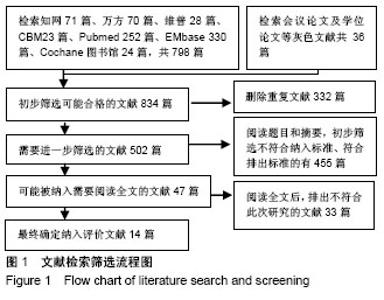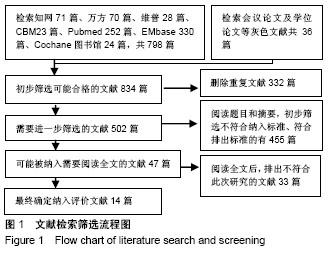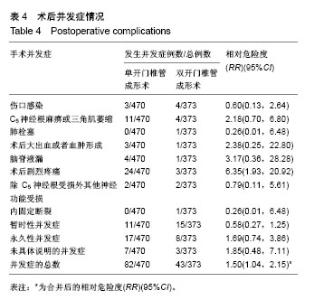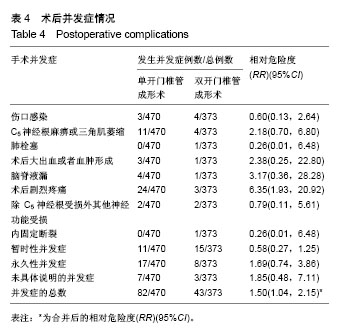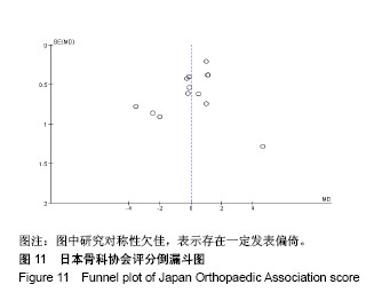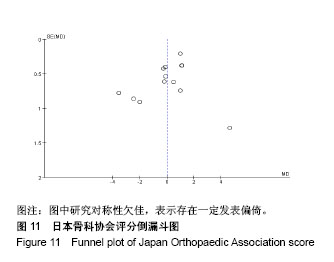Chinese Journal of Tissue Engineering Research ›› 2019, Vol. 23 ›› Issue (8): 1299-1306.doi: 10.3969/j.issn.2095-4344.1056
Previous Articles Next Articles
Cervical posterior single-door laminoplasty versus double-door laminoplasty for cervical spondylotic myelopathy: a meta-analysis
Liang Long1, 2, Wei Xu1, 2, Zhu Liguo1, 2, Yin He1, 2, Yu Jie1, 2, Feng Minshan1, 2, Chen Lin1, 2
- 1Wangjing Hospital of China Academy of Chinese Medical Sciences, Beijing 100102, China; 2Beijing Key Laboratory of Orthopedics of Traditional Chinese Medicine, Beijing 100102, China
-
Online:2019-03-18Published:2019-03-18 -
Contact:Zhu Liguo, MD, Chief physician, Wangjing Hospital of China Academy of Chinese Medical Sciences, Beijing 100102, China; Beijing Key Laboratory of Orthopedics of Traditional Chinese Medicine, Beijing 100102, China Yin He, Doctoral candidate, Attending physician, Wangjing Hospital of China Academy of Chinese Medical Sciences, Beijing 100102, China; Beijing Key Laboratory of Orthopedics of Traditional Chinese Medicine, Beijing 100102, China -
About author:Liang Long, Doctoral candidate, Physician, Wangjing Hospital of China Academy of Chinese Medical Sciences, Beijing 100102, China; Beijing Key Laboratory of Orthopedics of Traditional Chinese Medicine, Beijing 100102, China -
Supported by:the Research Project of Traditional Chinese Medicine, No. 201407001-11 (to ZLG)
CLC Number:
Cite this article
Liang Long, Wei Xu, Zhu Liguo, Yin He, Yu Jie, Feng Minshan, Chen Lin. Cervical posterior single-door laminoplasty versus double-door laminoplasty for cervical spondylotic myelopathy: a meta-analysis[J]. Chinese Journal of Tissue Engineering Research, 2019, 23(8): 1299-1306.
share this article
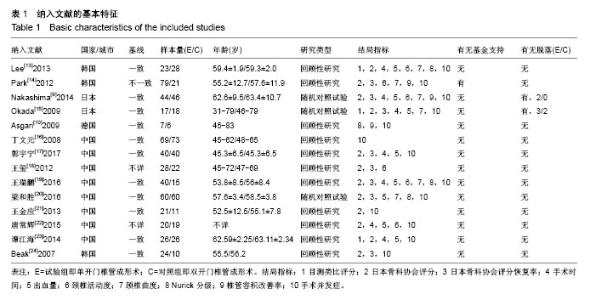
2.2 纳入研究的基本特征 纳入的14篇文献中,有3篇为随机对照试验[9,15,20],11篇为回顾性研究[10,13-14,16-19,21-24];6篇英文文献[9-10,13-15,24],8篇中文文献[16-23]。其中3篇文献来自韩国[13-14,24],2篇文献来自日本[9,15],1篇来自德国[10],余来自中国。有2篇学位论文[19,21],有2篇文献基线资料不详[18,22],1篇基线资料不一致[14]。1篇文献有基金支持[14]。 共纳入893例患者,其中治疗组有498例(55.76%),对照组395例(44.23%),试验平均样本量为59.53例。治疗组最大样本量为79例,最小样本量为7例;对照组最大样本量为73例,最小样本量为6例。2篇文献报道有脱落病例[9,15]。具体见表1。"
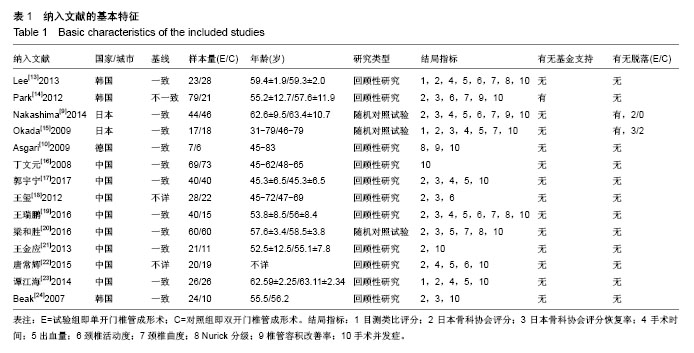
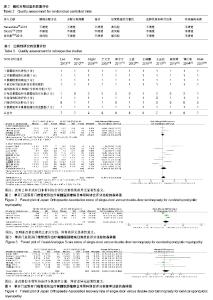
2.3 纳入文献质量评估 纳入的3篇随机对照试验选用Cochrane协作网推荐的偏倚风险评估工具,11篇回顾性研究选用NOS量表进行风险评估,每项研究均存在一定的偏倚,具体评估结果见表2,3。 2.4 Meta分析结果 2.4.1 日本骨科协会评分 共有13篇文献对2种术式改善日本骨科协会评分进行了评价[9-10,13-15,17-24],共纳入751例患者。各研究组间统计学上存在异质性(I2=82%),故选用随机效应模型进行统计分析,并根据研究类型的不同进行分组。分析结果显示,Z=0.77,[SMD=0.15,95%CI (-0.23,0.52)],P=0.44,无论质量较高的随机对照试验还是回顾性研究,均表明2种术式对日本骨科协会评分改善效果差异无显著性意义,具体见图2。 2.4.2 目测类比评分 共纳入3篇文献[13,15,23],共138例患者。异质性分析显示存在一定的异质性(I2=84%),采用随机效应模型。结果显示单开门椎管成形术与双开门椎管成形术比较,两者差异无显著性意义[SMD=0.24,95%CI(-0.64,1.11),P=0.6]。表明在改善目测类比评分方面,尚不能判断两者的优劣性,具体见图3。 2.4.3 日本骨科协会评分恢复率 共有7篇文献报道了日本骨科协会评分恢复率[9,14-15,18-20,24],共纳入484例患者。异质性分析结果(I2=9%),显示7项研究间具有很好的同质性,故采用固定效应模型进行分析。Meta分析结果显示,日本骨科协会评分恢复率的合并效应量以及95%置信区间为[MD=0.02,95%CI(-0.02,0.06)],单开门与双开门椎管成形术在改善日本骨科协会评分恢复率方面,无显著性意义(P=0.33),合并检验分析结果Z=0.97,具体见图4。"
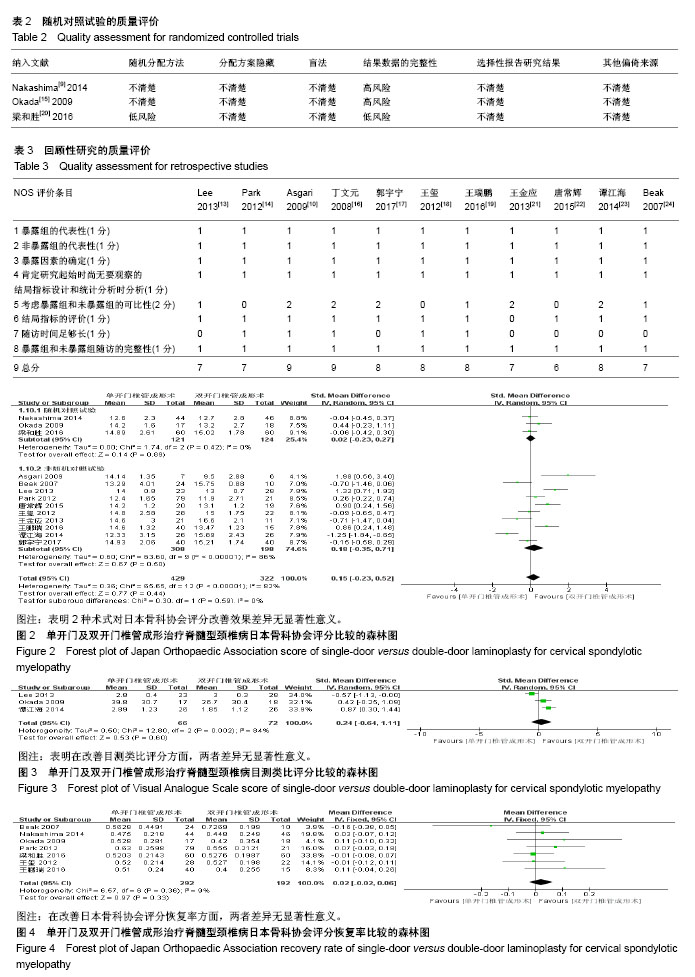
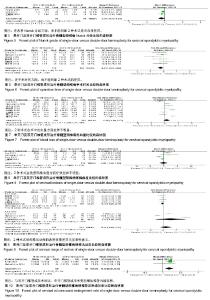
2.4.4 Nurick分级 共纳入3篇文献[10,13,9],共119例患者。异质性分析显示存在一定的异质性(I2=66%) ,采用随机效应模型。结果显示单开门与双开门椎管成形术相比,两者差异无显著性意义[SMD=-0.34,95%CI(-0.73,0.05),P=0.09]。表明在改善Nurick分级方面,尚不能判断2种术式是否存在差异,具体见图5。 2.4.5 手术时间 共纳入6篇文献[9,13,15,19,22-23],共322例患者。异质性分析显示异质性不明显(I2=5%),采用固定效应模型。结果显示单开门与双开门椎管成形术相比,两者差异无显著性意义[SMD=-0.21,95%CI(-0.43,0.02),P=0.07]。表明在手术时间方面,尚不能判断2种术式的差异,具体见图6。 2.4.6 出血量 共纳入6篇文献[9,13,15,19,22-23],共322例患者。异质性分析显示异质性明显(I2=86%),采用随机效应模型。结果显示单开门与双开门椎管成形术相比,两者差异无显著性意义[SMD=0.28,95%CI(-0.20,0.77),P=0.25]。表明2种术式在术中出血量方面差异不明显,见图7。 2.4.7 颈椎曲度 共纳入4篇文献[9-10,13-14],共296例患者。首先进行异质性检验,显示2组存在异质性(I2=83%),采用随机效应模型。结果显示单开门与双开门椎管成形术相比,两者差异无显著性意义[MD=0,95%CI(-0.49,0.77),P=1.00]。表明2种术式在改善颈椎曲度方面疗效差异不明显,见图8。 2.4.8 颈椎活动度 共有7篇文献提到2种术式对颈椎活动度的改善情况[9,13-14,18-20,22]。共纳入505例患者。各研究组间统计学上存在异质性(I2=95%),故选用随机效应模型进行统计分析,并根据研究类型的不同进行分组。分析结果显示,Z=0.90,[SMD=0.41,95%CI (-0.48,1.31)],P=0.37,无论国内研究还是国外研究均表明2种术式对颈椎活动度的改善效果差异无显著性意义,见图9。 2.4.9 椎管容积增加率 共纳入2篇文献[9,24],共124例患者。首先进行异质性检验,显示2组存在异质性(I2=0%),采用固定效应模型。结果显示单开门与双开门椎管成形术相比,两者差异有显著性意义[MD=0.18,95%CI(0.06,0.30),P=0.003]。表明单开门椎管成形术更能增加椎管内的容积,见图10。"
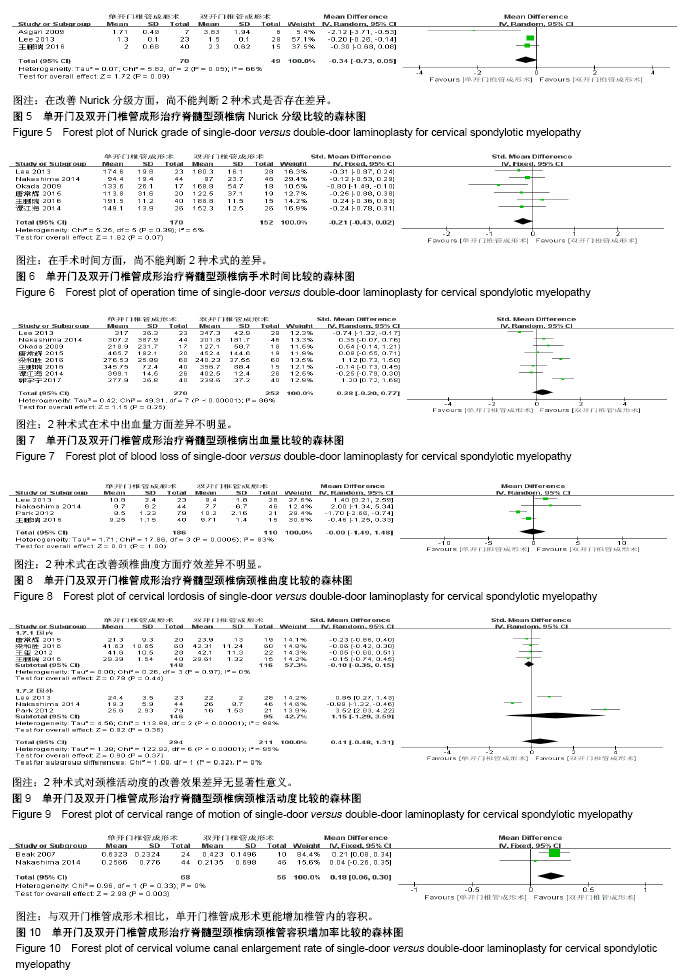
| [1] Toledano M, Bartleson JD.Cervical spondylotic myelopathy. Neurol Clin. 2013;31(1):287-305.[2] Boogaarts HD, Bartels RH.Prevalence of cervical spondylotic myelopathy. Eur Spine J. 2015;24 (Suppl 2):139-141.[3] Cao JM, Jing TZ, Da LY, et al. Imaging factors that distinguish between patients with asymptomatic and symptomatic cervical spondylotic myelopathy with mild to moderate cervical spinal cord compression. Med Sci Monit. 2017;23:4901-4908.[4] Luo J, Cao K, Huang S, et al. Comparison of anterior approach versus posterior approach for the treatment of multilevel cervical spondylotic myelopathy.Eur Spine J.2015; 24(8):1621-1630.[5] 于雷,袁绍辉.多节段脊髓型颈椎病手术策略的研究进展[J].医学综述,2018,24(1):117-121.[6] Nasto LA, Muquit S, Perez-Romera AB, et al. Clinical outcome and safety study of a newly developed instrumented French-door cervical laminoplasty technique. J Orthop Traumatol.2017;18(2):135-143.[7] Hirabayashi K, Watanabe K, Wakano K, et al. Expansive open-door laminoplasty for cervical spinal stenotic myelopathy. Spine (Phila Pa 1976). 1983;8(7):693-699.[8] Kurokawa T. Enlargement of the spinal canal by the sagittal splitting of spinous processes. Bessatsu Seikeigeka. 1982;2: 234-240.[9] Nakashima H, Kato F, Yukawa Y, et al. Comparative effectiveness of open-door laminoplasty versus French-door laminoplasty in cervical compressive myelopathy. Spine (Phila Pa 1976). 2014;39(8):642-647.[10] Asgari S, Bassiouni H, Massoud N, et al. Decompressive laminoplasty in multisegmental cervical spondylotic myelopathy: bilateral cutting versus open-door technique. Acta neurochirurgica. 2009;151(7):739-749.[11] Luo W, Li Y, Zhao J, et al. Open-versus French-door laminoplasty for the treatment of cervical multilevel compressive myelopathy: a meta-analysis.World Neurosurg. 2018;117:129-136.[12] Wang L, Wang Y, Yu B, et al. Open-door versus French-door laminoplasty for the treatment of cervical multilevel compressive myelopathy. J Clin Neurosci. 2015;22(3): 450-455.[13] Lee DG, Lee SH, Park SJ, et al. Comparison of surgical outcomes after cervical laminoplasty: open-door technique versus French-door technique. J Spinal Disord Tech. 2013; 26(6):E198-203.[14] Park JH, Roh SW, Rhim SC, et al. Long-term outcomes of 2 cervical laminoplasty methods: midline splitting versus unilateral single door. J Spinal Disord Tech.2012;25(8): E224-229.[15] Okada M, Minamide A, Endo T, et al.A prospective randomized study of clinical outcomes in patients with cervical compressive myelopathy treated with open-door or French-door laminoplasty. Spine (Phila Pa 1976). 2009;34(11): 1119-1126.[16] 丁文元,王磊,张为,等.颈后路两种手术方式治疗脊髓型颈椎病远期疗效比较[J].颈腰痛杂志,2008,29(3):239-241.[17] 郭宇宁,王俊波,贾本让.颈后路双开门椎管扩大成型术治疗脊髓型颈椎病的疗效[J].临床医药文献电子杂志, 2017,4(80): 15688-15688.[18] 王玺,李钦亮,刘艺,等.颈椎后路单、双开门椎管成形术治疗多节段脊髓型颈椎病的临床比较[J]. 颈腰痛杂志, 2012,33(2): 88-91.[19] 王鹏瑞.微型钛板改良单开门椎管扩大成形术与应用椎板线锯改良双开门椎管扩大成形术治疗多节段脊髓压迫型颈椎病的临床疗效比较[D].大连:大连医科大学,2016.[20] 梁和胜,肖立军,邓德礼.颈椎后路单开门与双开门椎管扩大修复多节段脊髓型颈椎病:颈椎活动度对比[J]. 中国组织工程研究, 2016, 20(22):3235-3241.[21] 王金应.颈椎后路单开门椎管扩大成形术与双开门椎管扩大成形术治疗多节段CSM的对比分析[D]. 福州:福建医科大学, 2013.[22] 唐常辉.两种手术方法治疗脊髓型颈椎病的临床疗效分析[J]. 中国保健营养, 2015,25(12):93.[23] 谭江海.双开门侧块螺钉固定植骨治疗多节段脊髓型颈椎病疗效观察[J].医药前沿, 2014,4(25):163-164.[24] Baek HC, Kang SH, Jeon SR, et al. Comparison of early surgical outcome between unilateral open-door laminoplasty and midline splitting laminoplasty. J Korean Neurosurg Soc. 2007;1(6):382-386.[25] Seng C, Tow BP, Siddiqui MA, et al. Surgically treated cervical myelopathy: a functional outcome comparison study between multilevel anterior cervical decompression fusion with instrumentation and posterior laminoplasty. Spine J. 2013; 13(7): 723-731.[26] Wang MC, Kreuter W, Wolfla CE, et al.Trends and variations in cervical spine surgery in the United States: Medicare beneficiaries, 1992 to 2005.Spine (Phila Pa 1976). 2009;34(9): 955-961.[27] 杨晓江,张扬,胡珊博,等.颈椎后路单开门椎管扩大成形术椎板开门值测量的新方法及新装置[J].国际骨科学杂志, 2018,39(3): 191-193.[28] 呼艳立.颈椎后路双开门椎管扩大成形术对颈椎管狭窄症脊髓功能的影响[J].深圳中西医结合杂志,2018,28(17):116-118[29] 范志丹,李青,梁道臣,等.颈椎后路单、双开门椎管扩大成形术在颈椎管狭窄症中的效果对比[J].中国当代医药, 2017,24(16): 98-100. |
| [1] | Chen Jinping, Li Kui, Chen Qian, Guo Haoran, Zhang Yingbo, Wei Peng. Meta-analysis of the efficacy and safety of tranexamic acid in open spinal surgery [J]. Chinese Journal of Tissue Engineering Research, 2021, 25(9): 1458-1464. |
| [2] | Hu Kai, Qiao Xiaohong, Zhang Yonghong, Wang Dong, Qin Sihe. Treatment of displaced intra-articular calcaneal fractures with cannulated screws and plates: a meta-analysis of 15 randomized controlled trials [J]. Chinese Journal of Tissue Engineering Research, 2021, 25(9): 1465-1470. |
| [3] | Huang Dengcheng, Wang Zhike, Cao Xuewei. Comparison of the short-term efficacy of extracorporeal shock wave therapy for middle-aged and elderly knee osteoarthritis: a meta-analysis [J]. Chinese Journal of Tissue Engineering Research, 2021, 25(9): 1471-1476. |
| [4] | Zhang Tongtong, Wang Zhonghua, Wen Jie, Song Yuxin, Liu Lin. Application of three-dimensional printing model in surgical resection and reconstruction of cervical tumor [J]. Chinese Journal of Tissue Engineering Research, 2021, 25(9): 1335-1339. |
| [5] | Wang Jinjun, Deng Zengfa, Liu Kang, He Zhiyong, Yu Xinping, Liang Jianji, Li Chen, Guo Zhouyang. Hemostatic effect and safety of intravenous drip of tranexamic acid combined with topical application of cocktail containing tranexamic acid in total knee arthroplasty [J]. Chinese Journal of Tissue Engineering Research, 2021, 25(9): 1356-1361. |
| [6] | Chen Junming, Yue Chen, He Peilin, Zhang Juntao, Sun Moyuan, Liu Youwen. Hip arthroplasty versus proximal femoral nail antirotation for intertrochanteric fractures in older adults: a meta-analysis [J]. Chinese Journal of Tissue Engineering Research, 2021, 25(9): 1452-1457. |
| [7] | Wang Yongsheng, Wu Yang, Li Yanchun. Effect of acute high-intensity exercise on appetite hormones in adults: a meta-analysis [J]. Chinese Journal of Tissue Engineering Research, 2021, 25(8): 1305-1312. |
| [8] | Zeng Yanhua, Hao Yanlei. In vitro culture and purification of Schwann cells: a systematic review [J]. Chinese Journal of Tissue Engineering Research, 2021, 25(7): 1135-1141. |
| [9] | Kong Desheng, He Jingjing, Feng Baofeng, Guo Ruiyun, Asiamah Ernest Amponsah, Lü Fei, Zhang Shuhan, Zhang Xiaolin, Ma Jun, Cui Huixian. Efficacy of mesenchymal stem cells in the spinal cord injury of large animal models: a meta-analysis [J]. Chinese Journal of Tissue Engineering Research, 2021, 25(7): 1142-1148. |
| [10] | Yuan Jun, Yang Jiafu. Hemostatic effect of topical tranexamic acid infiltration in cementless total knee arthroplasty [J]. Chinese Journal of Tissue Engineering Research, 2021, 25(6): 873-877. |
| [11] | Kong Lingbao, Lü Xin. Effect of implant selection and approach on support in the operation of posterolateral tibial plateau fractures [J]. Chinese Journal of Tissue Engineering Research, 2021, 25(6): 942-947. |
| [12] | Huang Dengcheng, Wang Zhike, Cao Xuewei. Intravenous, topical tranexamic acid alone or their combination in total knee arthroplasty: a meta-analysis of randomized controlled trials [J]. Chinese Journal of Tissue Engineering Research, 2021, 25(6): 948-956. |
| [13] | Li Yan, Wang Pei, Deng Donghuan, Yan Wei, Li Lei, Jiang Hongjiang. Electroacupuncture for pain control after total knee arthroplasty: a meta-analysis [J]. Chinese Journal of Tissue Engineering Research, 2021, 25(6): 957-963. |
| [14] | He Xiangzhong, Chen Haiyun, Liu Jun, Lü Yang, Pan Jianke, Yang Wenbin, He Jingwen, Huang Junhan. Platelet-rich plasma combined with microfracture versus microfracture in the treatment of knee cartilage lesions: a meta-analysis [J]. Chinese Journal of Tissue Engineering Research, 2021, 25(6): 964-969. |
| [15] | Hua Haotian, Zhao Wenyu, Zhang Lei, Bai Wenbo, Wang Xinwei. Meta-analysis of clinical efficacy and safety of antibiotic artificial bone in the treatment of chronic osteomyelitis [J]. Chinese Journal of Tissue Engineering Research, 2021, 25(6): 970-976. |
| Viewed | ||||||
|
Full text |
|
|||||
|
Abstract |
|
|||||
